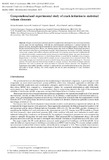JavaScript is disabled for your browser. Some features of this site may not work without it.
| dc.contributor.author | Kakandar, Ebiakpo | |
| dc.contributor.author | Castelluccio, Gustavo M. | |
| dc.contributor.author | Barrios, Alejandro | |
| dc.contributor.author | Pierron, Olivier | |
| dc.contributor.author | Maeder, Xavier | |
| dc.date.accessioned | 2020-03-19T14:31:51Z | |
| dc.date.available | 2020-03-19T14:31:51Z | |
| dc.date.issued | 2019-12-02 | |
| dc.identifier.citation | Kakandara E, Castelluccio GM, Barrios A, et al., (2019) Computational and experimental study of crack initiation in statistical volume elements. In: CMFF12 - 12th International Conference on Multiaxial Fatigue and Fracture, 24-26 June 2019, Bordeaux, France | en_UK |
| dc.identifier.issn | 2261-236X | |
| dc.identifier.uri | https://doi.org/10.1051/matecconf/201930010001 | |
| dc.identifier.uri | https://dspace.lib.cranfield.ac.uk/handle/1826/15313 | |
| dc.description.abstract | Fatigue crack formation and early growth is significantly influenced by microstructural attributes such as grain size and morphology. Although the crystallographic orientation is a primary indicator for fatigue cracking, the neighbourhood conformed by the first and second neighbour grains strongly affect the fatigue cracking driving force. Hence, two identical grains may result in different fatigue responses due to their interactions with their microstructural ensemble, which determines the fatigue variability. Naturally, macroscopic samples with millions of grains and thousands of competing microstructural neighbourhoods can effectively resemble a representative volume element in which fatigue failure may seem deterministic. However, when considering systems in which fatigue failure is controlled by hundreds or less of grains, fatigue failure is stochastic in nature and the samples are not a representative but a statistical volume. This work studies fatigue crack nucleation in micron-scale Ni beams that contain a few hundred grains. This work presents 3D crystal plasticity finite element models to compute stochastic distribution of fatigue indicator parameters that serve as proxies for crack nucleation in statistical volume elements. The integration of experiments with models provides a method to understand the irreversible deformation at the grain level that leads to fatigue cracking. Our results explain the role of grain morphology of crack nucleation distribution | en_UK |
| dc.language.iso | en | en_UK |
| dc.publisher | EDP Sciences | en_UK |
| dc.rights | Attribution 4.0 International | * |
| dc.rights.uri | http://creativecommons.org/licenses/by/4.0/ | * |
| dc.title | Computational and experimental study of crack initiation in statistical volume elements | en_UK |
| dc.type | Conference paper | en_UK |
Files in this item
The following license files are associated with this item:
This item appears in the following Collection(s)
-
Staff publications (SATM) [4364]

